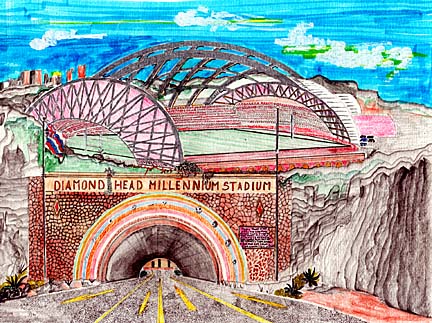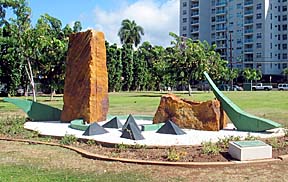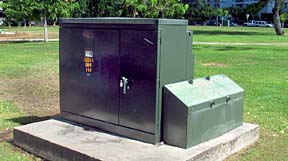
ILLUSTRATION BY JOHN WERRILL
Brainstormer John Werrill was told by an architect friend that the city wanted a "millennium stadium" at Diamond Head Crater. "However, I chose to ignore him," said Werrill.
101 things you can
do with a crater
We didn't exactly open any new cans of worms involving Diamond Head Crater. Lots of skullsweat over the years has been produced trying to come up with a suitable use for the hot, dry and dusty landmark. We did manage to freak out members of a citizen's advisory board who have put a lot of effort into their own proposals, which they apparently believe are close to being adopted.
"It was surprising to read in the Star-Bulletin that a column was being devoted to ideas for uses of Diamond Head. This has already been done with extensive community input," noted Wesley C. Kinder of Honolulu. That was in December, 1999. Then-Star-Bulletin reporter "Susan Kreifels wrote a story headlined 'Diamond Head Crater improvements OK'd,'" Kinder continued. "The subtitle was 'A visitors center, an interpretive center, more trails and a tram are among the developments approved by the land board.'
"Diamond Head is the second-most-visited site in Hawaii, and it deserves to be upgraded and preserved with care," Kinder added. "In the past, before it became the state monument, proposals for its use ranged from being used as a landfill to becoming a cemetery." (See the sidebar to this story for that plan's highlights.)
The arid conditions in the crater reminded some folks of Africa, and their thoughts turned to zoos:"Diamond Head Crater should be fenced and turned into an African plain -- which it already resembles -- and filled with the animals of the Serengeti. Open it for vehicle safaris. Build a lodge and restaurant. It works for San Diego, why not here?" -- George Robertson, Honolulu"Make the interior of Diamond Head an extension of Honolulu Zoo (in a natural setting) with animals that live in that kind of environment. It can be connected with a tram or rail system. A fee should be charged." -- Alfred and Simonne Rivera, Honolulu
"Make it green, not dead brown. Water the grass and trees with recycled water. Diamond Head Crater needs more shade trees to be planted. Make a safe campground for the Boy Scouts of America. Keep the trail clean. The crater needs a shower by the restrooms." -- John Fleener, Honolulu
And, by extension, some sort of learning center:"I'd like to see Diamond Head turned into a 'living museum' that would be a centerpiece that displays history and culture in a respectful way. The center of the crater could be planted with appropriate trees, shrubs, ferns and flowers to display examples of our agricultural and floral history and provide habitat for birds. Perhaps a garden of flora used for Haku lei-making could showcase the craft of making the lei. Another area could showcase plants used in Hawaiian medicine. One area could be used to showcase what the canoes of the Polynesian voyagers looked like and have volunteers discuss with participants what they brought with them and how it impacted the islands. Likewise, what did Captain Cook and others bring later and how did that impact the islands? Hiking and jogging trails would provide continued recreation to the many people who use the area now." -- Valisa Saunders, Honolulu"Establish a research center that entails the research and learning attitudes toward volcano sciences. This could be a facility used by Kapiolani Community College students, an ideal location for this particular discipline." -- Flo Daguio, Honolulu
"Diamond Head was so named because, for early sailors, when the sun shone on it, the minerals in the lava sparkled like diamonds. Let's not get cute about what to do with the crater of this extinct volcano, which has long been one of the planet's most recognized landmarks. Transform the Diamond Head crater into a world-recognized center for scientific research and development studies into the past, present and future of volcanos, and their profound influence on the existence of life on Planet Earth. Add companion facilities on the movement of tectonic plates, ocean floor research, and a conference center where the three scientific disciplines could easily meet to brainstorm together. The 'isolated, parched, largely windless desert' takes on a sparkling new international identity, one that puts mere diamonds to shame." -- Marjorie J. Scott, Kailua
Curiously, some folks, when they thought of Diamond Head, thought of trash:"(The) crater should be converted into a recycling education center. The newer gen- eration needs to learn how to compost, recycle, reuse and reduce our everyday waste. There are huge benefits to this concept and there are no easy answers, but this might be starting point. It would be a huge boost to our environment and, given the right planning , would make it a world-class facility for visitors and our community. The bulk of the trash comes from Honolulu and should not be hauled miles away."-- Alvin Wong, Pearl City"Why not sponsor a 'fill the head' contest? Encourage residents and tourists to toss uncrushed soda cans and bottles in Diamond Head Crater. Rubbermaid could be enticed to build a drive-thru lane where targets could challenge those who insist on tossing beer bottles at traffic signs. Tourists would flock from around the world to see the giant 'garbage can.' When Diamond Head is full, find another crater -- there are plenty around the islands. Why should we throw all the trash in gulches?" -- Dennis K. Biby, Honolulu
"Make it a giant garbage dump. When the mound reaches the dimensions of the original pre-eruption peak, cover it over with dirt and pretend it never erupted. The gas byproduct of garbage decomposition could be vented at the top and ignited to become a perpetual flame/natural lighthouse/tourist attraction." -- James R. Harstad, Honolulu
Fill the crater? Similar suggestions took a scientific or public-safety bent:"The idea of filling it with water is an excellent suggestion if the water is seawater, and the bottom can be sealed to prevent the contamination of adjacent areas. Then the elevation difference between the crater floor and the ocean could be used to install a 'pumped-storage' hydroelectric system that could store water pumped by off-peak electric energy to be used during the daytime peak periods. There would be a daily change in the elevation of the water level by several feet, but with a good design this could be accommodated and the lake could be useful for recreational activities. This idea was actually considered by the state of Hawaii in the early 1980s but never implemented. However, with the continuing need for new firm electric generating sources for Oahu, perhaps this concept deserves a second look?" -- Curtis Beck, Hilo"How about a radio telescope like Arecibo, or a giant concentrating solar array for power generation, or an active volcanic crater with red hot lava and flaming eruptions." -- Douglas Jess McCormick, Honolulu
"Who said Hawaiians ignored the crater? According to my grandparents, who were here in the 1930s, they were told the crater was used for sacrifices and capital punishment. So fill the crater with water and sacrifice drug dealers and car thieves, who we all love so much! We can hire CSI experts to make sure they don't float back to the top. Take school kids on a field trip to the crater to remind them what might happen if they decide to further their education in the wrong direction." -- Monica Lewis, Honolulu
Some fondly remembered the concerts that took place in the natural amphitheater during the 1970s:"Let it be used for music festivals and other events. The annual 'Crater Celebrations' were some of the highlights of each year." -- Fran Orian, Honolulu"Consideration for parking and traffic must be made. The roads won't support large intermittent events. Maybe a parking structure at the college could be constructed for joint use, and a restaurant and gift shop at the old Cannon Club site." -- Valisa Saunders, Honolulu
The bowl shape also made some folks think of sports:"Replace Ala Wai Golf Course with a course in Diamond Head Crater." -- John Worthington, Ewa"A velodrome for bicycle races; a wave machine with a rotating helicopter-like blade to generate two continuously breaking waves; a motocross track; a sprint car oval; a motorcycle flat-track oval; a skateboard park; an arboretum with bike paths on the circumference." -- Douglas Jess McCormick, Honolulu
"Why not have cable car lifts, like those in Switzerland, to take you up to the rim? Put in a restaurant(s) on the rim and we would have one of the premier attractions in the world. I know the boo birds are already shouting this one down as a desecration of a natural wonder. Well, the Swiss have these gondolas all over their beautiful mountains and I am thankful they do so we can enjoy the natural scenery. It is a great tourist attraction and every little town has a lift of sorts to attract hikers and skiers alike to the mountains. I also know what we do not need in the crater -- another golf course!" -- Dave Munson, Honolulu
"Diamond Head Crater can become the next football stadium, replacing the Aloha Stadium. Eliminate all the un- necessary buildings, level the playing field, cover with the turf of choice, construct stadium seats, dig more tunnels for vehicles and create parking lots. Lighting for night events can be designed so it is not seen from surrounding communities. Residents nearby would probably not approve of NASCAR stock-car racing in the crater facility, but when we talk about attracting tourism we should consider the fact that 150,000 fans attend NASCAR races." -- B. Ternst, Honolulu
And there's the do-nothing, nothing-doing contingent:"Why do we have to do anything with it? Leave it as it is right now or repair the damage to the landscape. I know this might be a difficult concept -- just let it alone. We have a finite amount of land. When all the government officials and developers have finished paving over paradise, it would be nice to have some green space left over. What's next, Kapiolani Park?" -- Fran Orian, Honolulu"Let's turn Diamond Head Crater into a nudist camp where the tourist can get a suntan without any visible tan lines to show off back home." -- Mike Nomura, Kailua
Master plan for crater
took decades to conceiveIt was dismaying to read that the Star-Bulletin was seeking ideas for what to do with Diamond Head -- even calling for ideas the wilder or nuttier the better in your September "Brainstorm" solicitations.
The Governor's Diamond Head Citizens Advisory Committee, made up of representatives from many nonprofit, environmentally conscious organizations, has been working for decades on a master plan for preserving one of Hawaii's natural treasures while still allowing -- and encouraging -- people from all over the world to go into this volcanic crater and climb its walls and experience its beauty and history.
Diamond Head is a national natural landmark and a state monument and should not be treated frivolously.
A master plan was first adopted in 1979 and has been updated several times. The final plan was adopted in 1999, followed by acceptance of an Environmental Impact Statement in 2001 by the governor. Our committee has worked intensively during the last few years with the Department of Land and Natural Resources and PER Hawaii to come up with this plan.
The plan is strong on preserving Diamond Head's geological and historical features and its native plants. It calls for removing unnecessary remaining military buildings, restoring a wetland and protecting endangered plants. It also calls for enhancing the visitor experience by building a low-impact interpretive center, adding trails to new viewpoints, opening up more historic military features -- a battery, tunnels and gun emplacements -- providing picnic areas, restricting vehicles in the crater and introducing a people-mover.
Diamond Head is the landmark of Hawaii recognized all over the world. It is one of the state's most visited places. Every day thousands flock into this crater of an ancient tuff cone and hike up to the high point on its rim. Diamond Head is a place just crying out to be the beneficiary of a sustainable tourism plan.
We are now working to come up with initial funding for the planned interpretive center -- our first priority.
E. Alison Kay
Chairwoman, Governor's Diamond Head Citizens Advisory Committee
BACK TO TOP |
Next month's Brainstorm!
BBURLINGAME@STARBULLETIN.COM
Pawa'a Neighborhood Park equally features this sign ...
BBURLINGAME@STARBULLETIN.COM
... and this geometric display of sculpture ...
You've seen them around town, those hulking steel boxes utility companies use to access circuits, or pipes, or workers' lunches, or whatever. They're generally painted institutional green in a ridiculous attempt to blend in with the landscape.
BBURLINGAME@STARBULLETIN.COM
... and this Green Mystery Box.
But they aren't successful. At Pawa'a Park on King Street, for example, there are three primary landmarks, as pictured here -- a piece of public art, a sign with the park's name and a Green Mystery Box.
Is there a better way to paint these boxes? Should the boxes be redesigned to be less obvious, or hidden?
Or should they be made as obvious as possible, celebrated for their contributions to our public utilities infrastructure? Should they be commissioned as original works of art?
Send ideas, drawings or sketches to: Brainstorm@starbulletin.com
Or mail them to:
Brainstorm!
c/o Burl Burlingame
Star-Bulletin
500 Ala Moana
7 Waterfront Plaza Suite 210
Honolulu, Hawaii 96813Fax: Brainstorm!
c/o Burl Burlingame
529-4750




